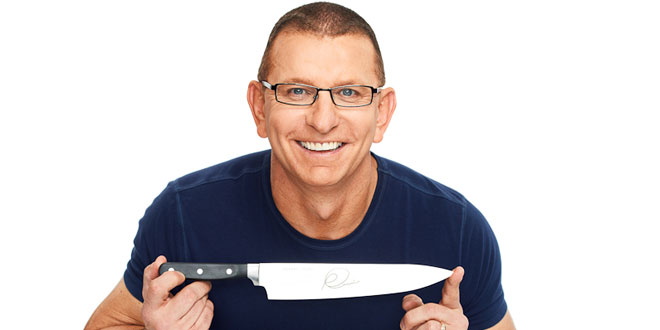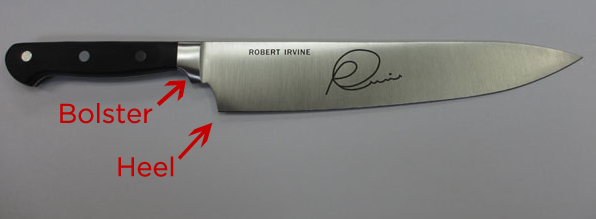
The Basics of Knives
In this post, I would like to discuss some of the basic knowledge about knife selection, features, and care that every beginner chef and home cook needs to know!
What are the most common knife types and what are they used for?
There are tons of different types of knives on the market (one for just about every task in the kitchen), but most home cooks and chefs really only need a select few. A good rule of thumb is to pair the size of the knife with the size of the task. Need to cut up an entire chicken or large melon? You’ll need a long chef’s knife that can reach through the entire diameter of whatever you are trying to cut in one slice.
Trying to dice an onion or slice a squash? A smaller/shorter blade, like a santoku, is perfect for this job. The 7 inch santoku that I offer has the added benefit of featuring a “granton” edge. These divots along the side of a blade keep food from sticking to the the blade, thus allowing a nice clean cut every time.
For smaller jobs like peeling and coring, you’ll need a paring knife. This lightweight and easy-to-handle blade allows for more intricate and detailed cuts.
Of course there are many other knives that are suited for more specific jobs like serrated bread knives and carving knives, but having these main three (chefs, santoku, and parer) will be more than enough to handle 90% of your slicing and dicing needs.
What’s important to keep in mind about the construction of a knife?
You’ll hear a lot of terms tossed around (balance, forge, tang, bolster, and heel) when the discussion of knife construction comes up. Some of these aspects are more important than others. Balance is fairly important in a knife’s comfortability and usability but, in my honest opinion, “perfect balance” has become a buzzword in the community when what you should be focusing on is just, “how does it feel in your hand?” As long as you don’t feel like you are trying to support the entirety of the knife’s weight blade while you hold it, you should be good. Forging refers to the knife’s strength from its construction and is incredibly important in the durability and life of your knife. All my knives are forged from stainless steel to ensure the highest quality and strength.
 The one feature that I focused on with my knife line was the inclusion of a “Western-style” recessed bolster. The bolster is where the blade meets the handle (or tang). Most knife companies feature a very thick bolster that extends all the way down to the heel of the blade. While this does guarantee a strong blade, it also creates a situation where, after repeated sharpening, the blade starts to recess where it meets the bolster and you get a small curve in the blade where it won’t cut anymore.
The one feature that I focused on with my knife line was the inclusion of a “Western-style” recessed bolster. The bolster is where the blade meets the handle (or tang). Most knife companies feature a very thick bolster that extends all the way down to the heel of the blade. While this does guarantee a strong blade, it also creates a situation where, after repeated sharpening, the blade starts to recess where it meets the bolster and you get a small curve in the blade where it won’t cut anymore.
This is a major problem resulting in having to get the bolster ground down by a professional. A western-style recessed bolster allow for the entire length of the blade to be sharpened thus extending the life of the knife, while still maintaining the greatest strength.
How should you properly store and maintain your knives?
While most knives are stainless steel, it is important to remember that any and all blades may corrode and dull in time. Store your knives in a wood block or another safe place. Storing knives in drawer with other silverware can dull and damage the blades. Proper care of your blades will guarantee continued sharpness, strength, and beauty.
Honing the knife’s blade with a sharpening steel prior to daily use can keep a razors-edge for a long time, and will also avoid nicks and burrs in the blade that can allow corrosion to start. Another key factor in maintaining blade sharpness is to only use wood and plastic cutting surfaces. Metal, ceramic, and marble cutting boards are the death of knife blades. Once you find that your regular honing is no longer keeping your knife as sharp as you prefer, it’s time for a professional sharpening. For most home cooks, this will likely need to happen 2-3 times per year. As a professional chef, I typically have my knives professionally sharpened once a month.
To avoid blade corrosion, make sure that you wash and dry your knife after every use. Leftover bits of food can quickly start the corrosion process. Most knives are dishwasher safe. My knives feature a POM thermoplastic handle and tough 3-rivet construction that can stand up to the high temperatures in a dishwasher. Even still, I would always suggest hand washing with mild detergent as a means of extending the life of the blade and handle. An extra step to extend blade and handle life is to wipe it down with oil. This is especially important if you foresee not using your knives for an extended period of time. Food-grade mineral oil is best, but olive or vegetable oil will work in a pinch.
I hope this helps you with any of the knife usage and care questions that you have.




